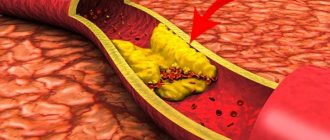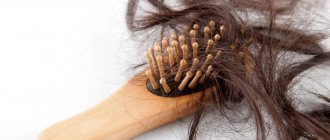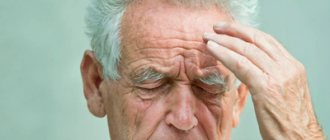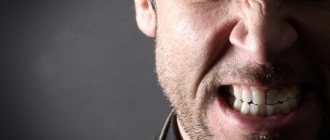02.07.2018
Head and neck diseases | Brain
Psychosomatics (from the Greek words “soul” and “body”) is a branch of medicine that seeks answers to the questions “why” and “how.” A “bad head” haunts not only the legs, but also other organs and systems of the body. It has been known for a long time that “psyche” and “physics” are closely connected and influence each other. In the occurrence of almost all bodily ailments, the state of a person’s psyche, if not the direct cause, then at least acts as a predisposing factor and subsequently significantly influences the course and prognosis of the disease.
Diseases in which this connection can be seen especially clearly are often called neurotic disorders (neuroses). This term refers to a wide range of disorders of the internal organs and systems, the cause or reason for which was psychogenic factors, for example, acute or chronic stress.
Stress itself is a protective reaction of the body, designed to help it cope with the “emergency” situation that has arisen and be prepared for its repetition. But the peculiarity of our time is that we are almost constantly in a state of stress. And it is caused (if we do not consider truly extreme situations) by factors that do not pose a direct threat to our physical survival. But very ancient mechanisms, designed to preserve life, work regardless of who is threatened from the outside - the body or the psyche. As a result, it turns out that the body’s reaction to stress becomes inadequate, meaningless and very energy-consuming. And sooner or later this leads to the depletion of adaptive reserves and the transformation of defense mechanisms into self-destructive ones.
For example, not long ago, neuroscientists found that when we are afraid that our opinion will not be approved and needs to be protected (argument, exams, etc.), our brain switches to an operating mode that ensures survival in a life-threatening situation: partially The cortical centers are blocked and the subcortical centers are activated, which activates the lightning-fast “fight or flight” mechanism. As a result, instead of sensible thinking, impenetrable dullness sets in, and instead of a conscious reaction, an “adrenaline storm” sets in.
Heart symptoms
With cardioneurosis, the main discomfort for patients comes from attacks of pain in the heart. Their intensity varies, as does the duration, which varies from 15 minutes to 2-3 days. An attack occurs mainly after stress. Its frequency is individual in each case. Suspicious people can experience discomfort 5 times a day. Other patients suffer from attacks of heart pain only 1-2 times a year due to nervous exhaustion.
Patients remember the manifested pain in the heart well and begin to worry greatly about their condition. The situation reaches the point of an obsession about imminent death. Cardiologists and therapists have to deal with particularly suspicious patients. Doctors try to explain to the patient that no organic lesions have been identified and recommend contacting a psychotherapist.
It is problematic to draw an overall clinical picture, since patients describe their condition in different ways. We have to focus on the most common cardiac symptoms of cardioneurosis:
- aching and throbbing pain combined with increased sensitivity of the skin on the part of the heart;
- feeling of emptiness in the chest;
- pain throughout the left half of the body with a focus in the heart area;
- pain radiating to the back, head, neck and genitals;
- pressing sensation in the chest;
- stabbing and cutting sensations in the chest, preventing deep breathing.
Pain in the chest is not relieved by Nitroglycerin tablets and other cardiac medications and decreases only after rest. You can distinguish an attack of cardioneurosis from heart disease by the following nuances in the patient’s behavior:
- When describing the symptoms of heart neurosis, the patient tries to embellish it and each time the story changes a little.
- An attack of cardioneurosis causes a person to have obsessive thoughts about imminent death and the “severity” of cardiac pathology. He becomes overly concerned about his health and often experiences panic attacks.
- An attack causes a person to fuss excessively, actively gesticulate, alternately apply cold and heat to the chest, and take all kinds of heart medications.
People who actually suffer from diseases of the cardiovascular system behave with restraint. They can take the medication recommended by the doctor and call an ambulance if necessary. With neurosis, a person is excessively fussy, which reveals his real illness. Calling an ambulance during an attack is often provoked by obsessive thoughts. Visiting doctors must distinguish real cardiac pathology from a panic attack and advise how to treat cardiac neurosis.
Symptoms
Since cardiac dyspnea (heart failure) is a complication and not an independent disease, often by the time it develops a person is informed about the presence of an underlying disease (hypertension, coronary heart disease, cardiomyopathy).
Shortness of breath is often accompanied by complaints such as increased blood pressure, massive chest pain, and interruptions in heart function.
With respiratory neurosis, an anxious personality type is revealed. Such patients are overly emotional, fussy, and their speech is confused. They associate lack of air with low oxygen levels and a feeling of chest tightness with a corset.
In addition to difficulty breathing, there may be complaints of a lump in the throat, tingling pain in the heart area, rapid pulse, palpitations, inability to relax, and difficulty falling asleep.
General clinical picture
The cardiac symptoms of cardioneurosis worry patients most of all, but other manifestations are also characteristic of the disease. Their intensity varies depending on the individual characteristics of the person. General symptoms of cardiac neurosis during an attack are usually the following:
- a feeling of anxiety that develops into panic;
- obsessive thoughts (obsessive syndrome) about imminent death and the development of fatal pathologies;
- feeling of a lump in the throat;
- lack of oxygen;
- frequent shallow breathing;
- feeling tired even with the slightest overload;
- inability to take a deep breath;
- headache;
- excessive sweating;
- alternating sensations of heat and cold throughout the body;
- loss of consciousness or faintness.
After the attack ends, the person feels a loss of strength and drowsiness. Heavy thoughts appear in your head that prevent you from falling asleep at night.
General symptoms and signs of neuroses
Based on the variety of life situations that cause internal conflict, the symptoms and signs of neuroses are often quite complex to identify variations in unusual reactions and behavior. In other words, very often a person does not correlate such reactions and behavior with the presence of a neurotic disease, considering them to be personality traits.
Neuroses can cause the emergence and development of somatic pathology. This is caused by a reaction to a stress factor, which provokes various disorders of the autonomic nervous system, which is responsible for the functioning of internal organs, glands, blood and lymphatic vessels.
As a rule, the personality of a neurotic combines variations of common characteristics characteristic of most cases:
- dependence on the assessment of others;
- illogical aggressiveness;
- hostile ambition;
- sexual compensation for low self-esteem;
- expression of pathologically inflated self-esteem;
- workaholism or, on the contrary, an infantile attitude to work;
- suppression of feelings of inferiority.
It is important to understand that the above symptoms and signs of neuroses reveal themselves in the dynamics of life. For example, in contrast to a non-neurotic personality, a person with neurosis will justify his illogical behavior, find reasons for fears, helplessness and passivity when it is necessary to make decisions, as in the case of aggression, hatred, and socially unacceptable actions on his part.
Rice. 1. Types and causes of neuroses.
Symptoms of neuroses in children and adolescents
According to some authors, mainly from a psychoanalytic direction, the prerequisites for the development of neuroses are unresolved internal conflicts in childhood and adolescence. As a rule, symptoms of neuroses in children and adolescents can manifest themselves against the background of difficult situations for a fragile psyche, addictive behavior of parents, which create the basis for the development of a full-fledged neurotic disorder, for example:
- strict upbringing, often with violence;
- family conflicts, divorce, alcoholism of one or both parents;
- development of feelings of insecurity, inferiority, helplessness.
At the same time, the symptoms of neuroses in children and adolescents can have either a pronounced character for others or be hidden behind an outwardly calm (depressed) state, masked as the “indifferent” character of the child. Such symptoms of neuroses include excessive tearfulness, touchiness, hysterical reactions, and manifestations of excessive and inappropriate aggression. Signs of neuroses that are more difficult to recognize as a psychopathological state are apathy, isolation, increased fatigue, and sleep disturbances.
Rice. 2. Neuroses and other diseases.
Symptoms and signs of neuroses in men
It is generally accepted that neurotic diseases are characteristic of women. In practice, neuroses occur equally in both women and men. The same can be said about the symptoms of neuroses, which are associated in the public consciousness with “unbalanced” reactions of women to stress - they are not alien to men.
The characteristic symptoms and signs of neuroses in men include the following:
- apathy;
- lack of initiative;
- fatigue;
- decreased speed of thinking;
- forgetfulness;
- inadequate (“violent”) reactions to situations;
- mood swings.
Due to the peculiarities of male upbringing, among the symptoms and signs of neuroses in men, in rare cases, there may be uncontrollable tearfulness, a tendency to public self-accusation or other attacks of a hysterical nature. In other cases, men simply find the strength to overcome the signs of “female” type neuroses or do not demonstrate them in front of other people.
Rice. 3. Neuroses among mental disorders.
Symptoms and signs of neuroses in women
Symptoms and signs of neuroses in women differ from those of the opposite sex due to the physiological characteristics of the body and the characteristics of upbringing. If in men, for example, reversible impotence is often encountered, then in women, amenorrhea is a symptom of neuroses similar in type to the “nature of sex”.
Among the symptoms and signs of neuroses in women, the most striking are:
- anxiety;
- irritability;
- expressiveness of behavior;
- refusal to eat;
- excessive tearfulness;
- mood swings.
More often in women than in male patients, among the symptoms of neuroses are complaints of insomnia, dreams of a frightening nature (up to the appearance of sleep paralysis) or difficulties in falling asleep. However, in each specific case, the complex of symptoms of neuroses will depend on the case and individual characteristics of the individual.
Causes
The development of cardioneurosis is influenced not only by external factors, but also by internal ones. A full list of reasons can be seen below:
- hormonal surges associated with illness, adolescence, pregnancy, menopause, taking medications;
- long-term course of pathology without improvement;
- constant feeling of stress;
- insomnia;
- frequent physical and mental overload;
- intoxication due to the effects of chemical compounds on the body;
- bad habits;
- poorly designed diet.
In childhood, the cardiac type of neurosis occurs against a background of stress during school or due to quarrels in the family, parental divorce and other factors that negatively affect the fragile psyche. In adolescence, the reasons remain the same, but the situation is aggravated by hormonal changes.
Neurotic disorder in children
Neuroses in children are quite common, and more often in boys than in girls. Sometimes their manifestations are difficult to mistake for symptoms of a disease. These are obsessive actions such as pulling out hair, picking your nose with your finger, pulling your earlobe, biting your lip, or sucking your fingers. Childhood neurosis can also manifest itself as compulsive counting. The child counts anything: steps, letters, squares of tiles, but he himself cannot give an explanation why he is doing this.
Other neurotic symptoms include:
- nervous tics - the child seems to wink, shrug his shoulders, stutter;
- fear reaching the point of panic. It is especially noticeable before bedtime. This could be the fear of going to bed, being alone, fear of the dark, fear of going to school;
- hysterics with fits and screams occur when the child’s wishes are not fulfilled;
- urinary incontinence.
Children with neuroses are lethargic, have poor appetite, and suffer from insomnia.
The cause of this condition is very often conflicting relationships in the family, especially the divorce of parents. Another group of provoking factors is a stressful situation accompanied by severe fear: a dog has bitten, a child has witnessed an unpleasant situation. The cause may also be fatigue, both mental and physical.
Other causes include past infections, intoxications, and damage to brain cells.
A child psychiatrist treats children's neurotic disorders. The main method of treatment is still psychotherapy. The following types are used: fairy tale therapy, play therapy, hypnosis. Medications are also used. These are mainly nootropic and restorative drugs, vitamin-mineral complexes, and sedative herbal remedies. Tranquilizers and antidepressants are used extremely rarely.
Parents are required to create a warm and friendly atmosphere in the family for their child. The daily routine should be distributed in such a way that there is enough space for both work and rest. It is very important to moderate your child’s presence on the Internet and be sure to involve him in some kind of sport.
First aid
The manifestation of cardioneurosis is difficult to predict, especially if a person has not previously experienced such discomfort. You can find out how to get rid of an attack of heart neurosis from the information below:
- During an attack, it is better for the patient to find a well-ventilated room to compensate for the lack of oxygen.
If possible, it is advisable to lie down on a sofa or bed. If they are missing, the floor will do.- Take any mild drug with a sedative (calming) effect (Valocardin, alcohol tinctures of motherwort, lemon balm, valerian).
- Take your pulse. If it can be easily felt and does not malfunction, this means that there are no severe functional impairments.
- Calm down and lie down, trying not to think about anything. Excessive fuss, constant measurements of pressure, pulse and calls to relatives and friends will only increase anxiety.
Relief occurs in about 15-20 minutes. To prevent further attacks, it is advisable to consult a therapist. He will send you for an examination and, based on its results, will draw up a list of recommendations. Drug treatment is required only in severe cases. In most cases, you can get by with lifestyle correction and traditional medicine. If the pain in the heart does not go away or the patient is in a pre-fainting state, then it is necessary to call an ambulance.
Diagnostics
The basic principle of diagnosis for cardioneurosis is aimed at excluding organic heart lesions (myocarditis, heart defects, coronary heart disease, vasculitis, etc.). In most cases, the doctor may suspect the presence of functional disorders even during the first examination of the patient, but to reliably exclude true cardialgia, the patient is prescribed the following research methods:
- laboratory tests of urine and blood;
- ECG;
- Echo-CG;
- treadmill test or bicycle ergometry;
- Holter monitoring;
- consultation with a neurologist and other highly specialized doctors.
Based on the absence of organic heart damage and the presence of the patient’s complaints listed above, the doctor can make a final diagnosis of cardioneurosis.
Drug treatment
Drugs are prescribed to relieve pain, normalize heart rhythm, relieve shortness of breath and calm the nervous system. The following groups of medications are mainly used:
- It is advisable to use sedative medications for a course lasting at least 1-2 months to obtain a lasting effect. Alcohol tinctures of herbs (motherwort, peppermint, valerian) and medications with a sedative effect (Valocordin, Validol, Persen) are used.
- Antidepressants (Pyrazidol, Amitriptyline, Imizin) suppress depression, improve mood and stimulate the nervous system. Initially, they often cause drowsiness due to the strong sedative effect, but the side effect gradually wears off.
- Tranquilizers (Seduxen, Phenazepam, Nitrazepam) relieve nervous tension and eliminate anxiety and fear. If the patient is more concerned about phobias that arose against the background of an attack of cardioneurosis, then it is better to take Seduxen. Nitrazepam effectively helps with insomnia, and Phenazepam is used to suppress depression.
- Associated headaches can be eliminated with analgesics (Citramon, Spazgan, Drotaverine).
- Vitamin complexes with a high concentration of B vitamins (“Neurovitan”, “Neuromultivit”) are used to improve the condition of the nervous system.
Potassium-containing drugs (Asparkam, Orocomag) are used to stimulate the conductive function of the heart and normalize the transmission of nerve impulses.
Vitamins, potassium-containing preparations and alcohol tinctures with a sedative effect can be taken without any particular concern. For chemical-based analgesics and sedatives, it is necessary to study the contraindications. It is prohibited to take antidepressants and tranquilizers on your own. They have a strong effect on the nervous system, so they are sold by prescription.
The exceptions are children under 18 years of age and women during pregnancy and breastfeeding. For these groups, drug therapy is selected only by the attending physician, who, after the examination, will tell you how to treat cardiac neurosis and advise safe methods. In other cases, you can self-medicate only at your own peril and risk.
Gymnastics for heart neurosis
Experts have developed a special complex of physical therapy for this pathology.
- Lunges for 1-1.5 minutes, first with one leg, then the other.
- Deflection of the torso. The leg is pulled back, the upper body also bends back. Then the same is done with the other leg. The exercise is repeated 5-8 times on each leg.
- Squat on one leg, while holding onto a chair. Repeat 2-5 times with each leg.
- Rotational movements of the body, first in one direction, then in the other. Repeat 3-6 times.
- Imitation of boxer punches. You need to breathe in a random order. Make 8-15 blows with each hand.
In some specialized neuropsychiatric clinics, there are special neurosis departments in which patients with different variations of this disease are treated. Often, patients are brought to such departments by the presence of panic attacks, which can often be combined with migraines or other pathologies that debilitate the patient.
Non-drug therapy
Treatment of cardioneurosis is possible without pills. The essence of non-drug treatment is lifestyle correction:
- try not to get into stressful situations;
- maintain a positive attitude;
- work no more than 7-8 hours a day and take 5 minute breaks once every hour and a half;
- devote at least 6-8 hours to sleep;
- do not overwork physically and mentally;
- walk in the fresh air for 1-2 hours every day;
- exercise (moderately), do morning exercises;
- give up bad habits (smoking, drinking alcohol).
Gymnastics for cardioneurosis should be moderate and aimed at strengthening the heart muscle. Running, swimming and aerobic exercise are good options.
The patient will have to change his diet to get rid of heart neurosis. By giving up fast food, sweets, spices and other unhealthy foods in favor of healthy foods, you can significantly improve your overall health. The daily menu should include more vegetables and fruits. It is advisable to eat at least 4-5 times a day, in small portions. The last meal should be 3-4 hours before bedtime.
People who spend most of their time working need to dilute their busy schedule. You should rest at least 2-3 hours a day, doing your favorite hobby, listening to music or going to a massage.
How are neuroses treated?
Treatment of neuroses is primarily carried out with the help of psychotherapy . This is the main tool in overcoming the disease, which cannot be replaced even by medications.
But initially, the impact of the psychotraumatic factor should be canceled. This can be done in two ways:
- the first is to eliminate the situation;
- the second - as in the saying: “If you cannot change the situation, then change your attitude towards it.” This is what psychotherapy does.
There are two types of psychotherapeutic methods: primary and auxiliary.
Basic psychotherapy is aimed at eliminating the cause of the disorder. The auxiliary method enhances the effect of the main one and consolidates the result. Psychotherapy using purely auxiliary methods is ineffective. Among psychotherapeutic methods, special attention is paid to cognitive behavioral therapy. It is especially effective in the treatment of obsessive neuroses. A technique is used that provokes the client to have obsessive thoughts or actions. It is believed that in this way a person will get used to them, and they will cease to have a frightening character. In addition, this technique allows you to escape from obsessions.
To eliminate anxiety, behavioral therapy uses methods to help change incorrect attitudes, as well as methods of coping with stressful situations. To get rid of phobias, a person is deliberately immersed in a frightening situation. For example, if he is afraid of public speaking, he is forced to give a lecture or report to a group of people.
Other types of psychotherapy are also used:
- existential;
- Gestalt therapy;
- hypnosis;
- art therapy;
- interpersonal therapy;
- psychoanalysis;
- auto-trainings.
Drug treatment of neurotic disorders reinforces and enhances the positive effect of psychotherapy. The following groups of drugs are used:
- Antidepressants are drugs for normalizing mood and eliminating anxious, depressing symptoms. They can be either chemical or plant based. They are able to stop even deep forms of the disorder;
- tranquilizers - there are several classes of such drugs. Some of them are used to eliminate mild neurotic symptoms, while others fight the most obvious manifestations of the disease. Tranquilizers are prescribed in cases where neurosis is accompanied by fears and anxiety;
- neuroleptics are effective for the hysteroid form of the disorder;
- mild depression can be eliminated with herbal remedies and infusions.
Other groups of drugs used for the treatment of nervous disorders include complexes of vitamins and minerals, adaptogenic agents based on Eleutherococcus, ginseng, Rhodiola rosea, sedative herbal preparations and sleeping pills.
Physiotherapeutic procedures include:
- massage;
- water and mud therapy;
- electrosleep;
- Darsonvalization.
symptomatic therapy becomes an additional treatment method . It eliminates negative signs that arise in a particular organ. Such drugs can be painkillers, as well as drugs that improve digestion, mild heart medications, and “distraction” tablets - Validol.
For help in the treatment of neuroses, you can contact the Moscow City Psychoendocrinological Center.
Psychotherapy
Taking medications alone can stop the manifestations of the disease, but cannot eliminate its cause. To completely cure cardioneurosis, you will have to normalize the functioning of the nervous system with the help of a psychologist or psychotherapist. Communication with a specialist will eliminate the feeling of anxiety, clear your head of obsessive thoughts and strengthen your psyche to effectively resist panic attacks.
Specialists mainly use the following methods of psychotherapy:
- Rational treatment. The doctor helps the patient understand why attacks occur and then teaches him how to effectively deal with them.
- Cognitive behavioral therapy. During the conversation, the psychotherapist talks about the patient’s actions that provoke the development of cardioneurosis and points out his mistakes in order to prevent their recurrence in the future.
- Family sessions. You can come to a conversation with a specialist with close people with whom the patient spends most of his time. Family psychotherapy is most effective for treating couples and children. During the sessions, the doctor will learn about problems and recommend methods to eliminate them.
- Hypnosis is used if the patient is unwilling or unable to share the hidden reasons for his condition. The specialist will put him to sleep and learn about all the problems on a subconscious level.
To achieve noticeable results, it usually takes about 10-15 sessions. It is advisable to combine them with lifestyle correction. The doctor will recommend drug treatment if necessary.
Symptoms of anxiety neurosis
Anxiety neurosis can manifest itself in various symptom complexes, depending on the specific case. Among such somatic and physiological manifestations associated with disruption of the autonomic nervous system, as well as mental symptoms of anxiety neurosis, the following are often noted:
- anxiety;
- fear;
- agitation;
- depression;
- obsessive thoughts;
- sleep disorders;
- headache;
- heartbeat disturbances;
- changes in blood pressure;
- breathing problems;
- gastrointestinal disorders.
Folk remedies
Folk remedies help with the treatment and relief of symptoms of heart neurosis. In most cases, herbal teas with a sedative effect are used. They actually have no contraindications, except for individual intolerance, but during preparation it is important to follow the dosages indicated in the recipe. If you exceed them or underestimate them, the effect will be too strong or completely absent. As a standard, 1-2 tbsp is taken for preparing the decoction. l. main ingredient per 500 ml of water or alcohol. Then the resulting mixture is thoroughly mixed and left to infuse.
The following folk remedies are the most effective for treating and relieving symptoms of heart neurosis:
- A decoction of mint and valerian roots calms the nerves well. You can prepare the medicine by taking 1 herb or both in equal proportions. It is taken instead of tea, 2 times a day.
- The combination of dried apricots, raisins and hawthorn, viburnum and rowan fruits will saturate the body with the microelements necessary for the normal functioning of the heart and nervous system. Prepare like a regular decoction. You can drink it instead of tea 2-3 times a day.
- Drink warm milk at night with the addition of 1 tsp. honey improves sleep and calms the nervous system.
The following fees can be used as a remedy for the treatment of cardioneurosis:
- mint, valerian roots, hop cones, three-leaf watch;
- hawthorn fruits, oregano, motherwort;
- hop cones, yarrow, valerian roots, lemon balm.
After preparing one of the decoctions, it should be taken 3 times a day, 100 ml. Course duration – 1 month. If allergy symptoms occur, treatment of heart neurosis with folk remedies is stopped, and you should consult a doctor as soon as possible.
Treatment
When the first intense attack of cardioneurosis appears, the patient needs to provide first aid:
- Try to calm the patient down by talking to him in a calm and confident voice.
- If possible, eliminate the factor that provokes psycho-emotional or physical stress (stop the quarrel, distract from painful memories, etc.).
- Provide fresh air or take it outside.
- If possible, remove the patient from a crowded room and put the patient to bed, providing him with optimal temperature conditions.
- Measure blood pressure. Make sure your pulse is regular and there are no circulatory disorders.
- Give the patient a sedative: Valocordin, Barboval, Persen, Sedavit, tincture of valerian or motherwort, Novo-passit, etc. The medicine should be taken throughout the day, repeating the sedative after 3-4 hours.
- If a headache occurs, you can give the patient an anesthetic drug: Nurofen, Citramon, Spazmalgon, etc.
- It is not recommended to massage the patient or apply a heating pad.
- If the patient’s condition does not improve, but worsens, then it is necessary to immediately call a doctor or an ambulance team.
After the first signs of cardioneurosis appear, the patient is recommended to consult a doctor and undergo a comprehensive examination, excluding the presence of other pathologies and determining the form of neurosis (hypo- or hypersthenic). Treatment of this disease cannot be delayed, because in later stages it is less responsive to treatment and may be complicated by the appearance of cardiac pathologies.
Non-drug therapy and mental comfort
The development of cardioneurosis in almost 100% of cases is associated with psychosomatics, that is, with such psychological discomfort that causes the appearance of physical symptoms. Working with a neurologist, psychologist or, in some cases, a psychotherapist will help to uncover such causes of psycho-emotional instability and worries. Dissatisfaction with oneself, others or loved ones, working conditions and other life situations - these are the primary sources of cardioneurosis that lead to depletion of the nervous system and the body as a whole. They can be eliminated by working on oneself. The doctor selects the methodology for such auto-training individually for each patient.
In addition to such work on oneself, patients with cardioneuroses are recommended to:
- Adjust your work and rest schedule.
- Get enough sleep.
- Take frequent walks in the fresh air.
- Do physical exercise or your favorite sport.
- Find a hobby and make time for it.
- Take a contrast shower.
- Get rid of bad habits.
- Normalize your diet: exclude foods that stimulate the nervous system from your diet and introduce balanced and vitamin-rich foods into your daily menu.
- Do not pass or eat food before bedtime.
- Follow all doctor’s recommendations and treat chronic diseases in a timely manner.
Drug therapy
In the hypersthenic form of cardioneurosis, the patient is recommended medications that increase the threshold of nervous excitability:
- Chlordiazepoxide;
- Amizil;
- Teralen;
- Trioxazine, etc.
In the case of a hyposthenic form of cardioneurosis, the patient is recommended to take general restoratives and medications that stimulate the functioning of the nervous system:
- Trioxazine;
- B vitamins (B1, B6 and B12);
- tincture of Eleutherococcus;
- Securin;
- Diazepam, etc.
If the patient is prone to obsessive states and is overly emotional, then he is recommended to take preparations of hawthorn (Hawthorn forte, Kratal, Krategus-Hel, Neocardil), valerian and motherwort. In particularly acute periods, taking Eunoctin or Seduxen may be recommended.
In some cases, cardioneurosis in women experiencing menopause is caused by hormonal changes in the body. Such patients are recommended to take short courses of the following drugs:
- Preductal;
- Triductane;
- Mildronate;
- Magne B6.
Remember that self-medication of cardioneurosis is extremely undesirable! All of the above drugs for the treatment of cardioneurosis should be selected only by a doctor and taken not once, but in courses. The patient should be aware that while taking certain medications, one should not drive or operate other complex machinery, as they may cause a delayed reaction.
ethnoscience
In some cases, folk remedies that have a general strengthening and calming effect can be a good alternative to medications for the treatment of cardioneurosis. When choosing a prescription for the treatment of such an ailment, be sure to consult with your doctor about the possibility of its use and make sure that there are no contraindications or individual intolerance to the components of the folk remedy.
The following folk recipes can be used to treat cardioneurosis:
- herbal collection of motherwort, oregano and hawthorn fruits;
- herbal collection of hop cones, trifoliate, mint and valerian rhizomes;
- herbal mixture of yarrow, St. John's wort and arnica;
- peony tincture;
- natural honey with pollen;
- spring adonis extract, etc.
When preparing herbal infusions, you should follow all recommendations regarding the method of brewing herbs, dosages, frequency and time of administration. We should not forget that taking sedative folk remedies can also affect the speed of reaction when driving a car and controlling other complex and dangerous mechanisms.
Cardioneurosis can significantly disrupt the usual rhythm of life of each person and, in later stages, lead to the development of heart and vascular diseases. Don't put off his treatment until later! In the initial stages, following the doctor’s recommendations contributes to the effective and long-term elimination of attacks. Remember this and be healthy!
Forecast
Cardioneurosis is successfully eliminated in the early stages. Residual effects and relapses do not occur with an integrated approach to treatment.
In its advanced state, the disease has a detrimental effect on the patient’s psycho-emotional background. He becomes suspicious, overly irritable and fearful. A constant feeling of anxiety negatively affects all internal processes. Basically, the stool is disrupted, hypertension and angina develop. Treatment will be aimed at reducing nervous excitability and stabilizing the digestive and cardiovascular systems.
Cardioneurosis is a psychosomatic disease. Its development is provoked by frequent stress and overwork. The main problem arises in the diagnostic process. To differentiate cardiac neurosis, the therapist will have to exclude all similar pathological processes. After successful diagnosis, the patient is given recommendations for lifestyle correction. In advanced stages, medication may be prescribed. Psychotherapy and folk recipes are successfully used to complement the course of treatment.
Symptoms of hysterical neurosis
Symptoms of hysterical neurosis (F44 according to ICD-10) include behavioral characteristics and reactions of a somatic nature. In addition to emotional imbalance, a strong reaction (positive, negative) even to minor events in life, the following signs that arise against the background of a pathological condition should be noted:
- convulsions, tremors;
- problems with coordination of movements;
- loss of speech abilities;
- stuttering;
- loss of sensation;
- hearing loss;
- loss of vision;
- loss of facial expressions;
- paralysis;
- vegetative disorders.
What other symptoms can be observed with neurosis?
In addition to the above clinical manifestations, additional symptoms may be observed:
- One of the types of cardioneurosis is autonomic neurosis, which is often present as a symptom complex in pathological menopause, and in addition, in other hormonal disorders. In the presence of a pathological menopause, autonomic neurosis is called autonomic dyshormonal cardiodystrophy. Clinically, this disease can manifest itself as cardialgia of a cutting and pressing nature. Sometimes the pain can radiate to the arm and shoulder blade; among other things, the rhythm may become faster. Such painful sensations do not depend in any way on physical activity, and a state of rest as such does not bring relief. In addition, Nitroglycerin also does not give any effect.
- Symptoms in the form of sweating, hot flashes, shortness of breath, dizziness, parasympathetic crisis, tachycardia or bradycardia, trembling, hyperemia or pallor of the skin indicate some specific autonomic problems.
- With cardiac neuroses, manifestations in the form of high blood pressure, headaches and heart pain can also be observed.










